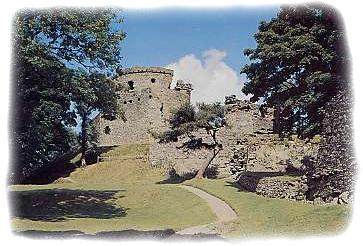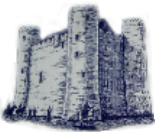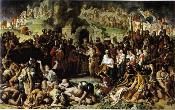|
|
Events leading up to
The Normans Invasion of Ireland. |
| |
Read
about The Anglo Norman Invasion
From 'A Concise History of Ireland' by P
W Joyce |
||||
An immediate invasion of Ireland did not at the time suit Henry II, however with his own position on the English throne secured the perfect opportunity arose after an incident when Dermot McMurrough King of Leinster attacked his neighbour Tiernan O'Rourke, king of Breifne (Leitrim Cavan area) McMurrough made off with O'Rourke's livestock and also his wife Dervorgilla. O'Rourke enlisted the help of Turlough Mor O'Connor the high king and eventually in 1166 McMurrough was driven from Ireland. He made his way to England where he petitioned Henry to help him regain the kingship of Leinster, Henry readily agreed appointing Richard FitzGilbert de Clare (Strongbow) the leader of the Norman Knights for the invasion, McMurrough promised his daughter Aoife's hand in marriage to Strongbow as well as succession to his kingship of Leinster. |
||||
|
|
The
Invasion of Ireland Begins. |
||
|
On May 1st, Rory O'Connor, who had succeeded Turlough Mor O'Connor as high king of Ireland, had Rory acted descively in all possibility he could have easily defeated this small force, however it was not to be and the Normans having established a bridgehead quickly reinforced it. Rory's failure to expel the Normans led to his abdication in favour of his son Conor Moinmoy, while he retired to Cong Abbey which he had founded, there he lived the rest of his life as a monk until his death in 1198 after which he was buried in the abbey. Thirty years later in 1228, Rory's body was reburied beside his father's at Clonmacnoise in County Offaly. His death brought to an end a monarchical system that had endured for nearly a millennium. In 1170, Strongbow landed near Waterford with an army, captured the town, and married Eva MacMurrough there. The first part of the agreement had been kept. The second part soon followed. After the Normans had captured Dublin, MacMurrough fell ill with a mysterious illness he died some time later. Strongbow assumed the title king of Leinster, and he other Norman barons began to seize territories. Henry II was alarmed by these events, he had no intention of allowing any of his subjects to set up independent kingdoms in Ireland. In 1171, he crossed to Ireland to assert his authority over Strongbow and to find out whether he could repeat the rather easy successes his barons had already achieved. The Normans submitted to him at once, as did many Irish kings and princes. The Irish may have believed that, if they recognized Henry as their overlord, he would protect their property. They were to be disappointed. Henry confirmed Strongbow in his possession of Leinster. He made Hugh de Lacy his Justiciar (viceroy) and granted him the kingdom of Meath. After Henry II returned to England, the Normans continued to seize the lands of the Irish princes. In the Centre's of Ireland, the territories under Norman rule stretched from Dublin across the central plain. The De Lacy's held lands in Meath and Westmeath and the De Burghs controlled large areas of Connacht. In the south west, the Fitzgerald's held lands in Leinster and on the south bank of the Shannon estuary, and the Butlers controlled territories in East Munster. In the north, John de Courcy seized the old kingdom of Ulster and ruled an area east of the Bann, from Fair Head to Carlingford Lough. Go to History of Ireland home page. |
||
|
|
|
|
 to Norway and enlisted the help of the Norwegian
King Harold Hardrada, a fleet of some
three hundred ships were assembled. Setting sail for England they
landed on the coast of Northumbria where they won some small skirmishes.
They were met at Stamford bridge near York on 25th September by
the main body of Harold's army which inflicted a crushing defeat
on the invaders, both Tostig and Hardrada being killed. The magnitude
of the defeat is indicated in the fact that of the original three
hundred ships only twenty four made the return journey to Norway.
to Norway and enlisted the help of the Norwegian
King Harold Hardrada, a fleet of some
three hundred ships were assembled. Setting sail for England they
landed on the coast of Northumbria where they won some small skirmishes.
They were met at Stamford bridge near York on 25th September by
the main body of Harold's army which inflicted a crushing defeat
on the invaders, both Tostig and Hardrada being killed. The magnitude
of the defeat is indicated in the fact that of the original three
hundred ships only twenty four made the return journey to Norway.
